Every ethnic group has what it calls ‘soul food’ – soothing, comfort food that brings back warm memories of family dinners.
Source: A History of Soul Food
 If you ask an African-American, as the term ‘soul food’ originated from the cuisine developed by the African slaves mainly from the American South, he would define it as a result of how good they can cook with whatever is available and still come up with something nourishing and scrumptious at the same time.
If you ask an African-American, as the term ‘soul food’ originated from the cuisine developed by the African slaves mainly from the American South, he would define it as a result of how good they can cook with whatever is available and still come up with something nourishing and scrumptious at the same time.
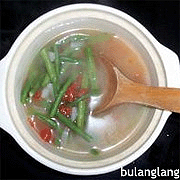 With the way my mom cooks and the above as my guideline for the definition or interpretation of soul food, then I would say we were nurtured with such for years. Batanguenos, like my mom, are well-known to cook in the most fundamental way – boiling, frying, stewing, grilling – and with minimum spices available but blended in the right way. Come to think of it. The dishes are easy-to-cook, healthy and mostly oil-free. Simple yet hearty and delicious. Sinaing na isda, pais, bulanglang, bulalo (oil-free?), halabos na alimasag (crab) or katang (talangka or small crabs, fresh-water i guess). Ingredients that are readily available. Their famous beef, tulingan, maliputo, tawilis, kamias.
With the way my mom cooks and the above as my guideline for the definition or interpretation of soul food, then I would say we were nurtured with such for years. Batanguenos, like my mom, are well-known to cook in the most fundamental way – boiling, frying, stewing, grilling – and with minimum spices available but blended in the right way. Come to think of it. The dishes are easy-to-cook, healthy and mostly oil-free. Simple yet hearty and delicious. Sinaing na isda, pais, bulanglang, bulalo (oil-free?), halabos na alimasag (crab) or katang (talangka or small crabs, fresh-water i guess). Ingredients that are readily available. Their famous beef, tulingan, maliputo, tawilis, kamias.
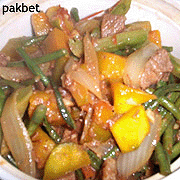 That explains her most common phrase “I didn’t know how to cook before I married your dad.” Our dad, an excellent cook, exposed her to Ilocano dishes such as papaitan (a bitter stew of goat meat and innards which I finally appreciated in my late teens together with beer-drinking) and pakbet (eggplant, bittergourd, okra, squash and string beans cooked in fish paste), another common dish on our dining table. As they say about Ilocanos, subtlety is not found in their gastronomic dictionary. Pakbet (or pinakbet, probably their most popular dish), papaitan, kilawen, ar-arusep (a type of seaweed served as a salad mixed with chopped tomatoes & bagoong), malunggay, saluyot (tender leaves that thickens soup the same way as okra can).
That explains her most common phrase “I didn’t know how to cook before I married your dad.” Our dad, an excellent cook, exposed her to Ilocano dishes such as papaitan (a bitter stew of goat meat and innards which I finally appreciated in my late teens together with beer-drinking) and pakbet (eggplant, bittergourd, okra, squash and string beans cooked in fish paste), another common dish on our dining table. As they say about Ilocanos, subtlety is not found in their gastronomic dictionary. Pakbet (or pinakbet, probably their most popular dish), papaitan, kilawen, ar-arusep (a type of seaweed served as a salad mixed with chopped tomatoes & bagoong), malunggay, saluyot (tender leaves that thickens soup the same way as okra can).
Looking back now and after contemplating on how I was described as an adventurous eater and cook, I must have acquired the spirit from being somebody who grew up in the southern Tagalog region born of parents with so much cultural differences. Matapang at kuripot (bold and frugal)? Well, at least when we talk about culinary. Our soul food? One day it is an easy-to-cook meal, the next day it’s something tedious to prepare. From time to time, the ingredients to the food on our table changes quantity but never quality along with the family’s financial condition tightly synchronized with the country’s economic status. Nevertheless, the essential soulfulness is always there that helps define our food experience and outlook on life.
All Soul’s Day is a Roman Catholic day of remembrance for friends and loved ones who have passed away. This comes from the ancient Pagan Festival of the Dead, which celebrated the Pagan belief that the souls of the dead would return for a meal with the family.
Source: All Soul’s Day
As a young kid, all soul’s day was always a trip to the province to visit the grave of my lolo, my mom’s ama, whom I never had the chance to meet. What I knew about him are all through the mesmerizing stories of my blind lola. Years ago he was laid in the town’s cemetery, so crowded during such a time in a country where most are Catholics. When she passed away during my late teens, she was laid to rest together with the ashes of her esposo (taken from the old cemetery) in a memorial park with a huge statue of the country’s national bird on its entry gate. Well, that’s also the owner’s surname – a nephew of lola.
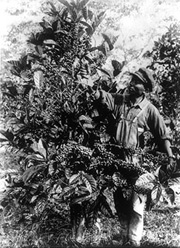
All those years, we always proceed to have lunch either at an aunt’s home or my lola’s bahay na bato which, at that time, was a sight to behold in the neighborhood. I had fond memories of suman (a delicacy of sweet glutinous rice wrapped in banana leaves), hot chocolate made of tablea (chocolate tablets made from cacao beans), kapeng barako (brewed coffee made of a bean variety fresh from lola’s own backyard), dinuguan and ofcourse, sinaing na tulingan, must be the most common Batangueno dish. All but one is unquestionably Batangueno. Though I don’t think a Batangas cuisine, dinuguan – ruby-red pork stew flavored w/ pork blood spiked with pepper, garlic & vinegar, remains one of the most requested dish in family gatherings. I remember a time when we were playing takutan or aswang-aswangan (make belive vampires), a cousin said in her vampire voice “I will drain your blood and use it for dinuguan.”
As they say, the history of trick o’ treating can be traced back to the early celebrations of All Soul’s Day in Britain. The poor would go begging and the housewives would give them special treats called soulcakes. This was called going a-souling, and the soulers would promise to say a prayer for the dead.
Source: Trick O’Treat!
Trick or treat? Here’s a treat – 2 recipes! The 1st one is no other than sinaing na tulingan – tuna placed on top of a layer of sun-dried kamias & pork fat in a palayok (clay pots), and simmered over low fire. They say that the tulingan’s tail is poisonous if improperly prepared. However, my mom has cooked this fish at home for maybe a million times and in a wide variety of styles like pais (wrapped in banana leaves and cooked the same way as sinaing na tulingan) or ginataan sa mustasa (cooked with coconut milk & mustard leaves) and nothing has ever happened to anyone of us. When confronted by such a comment, she would just brush it off and say “they just don’t know how to cook it the right way – true-blue ala eh style.”
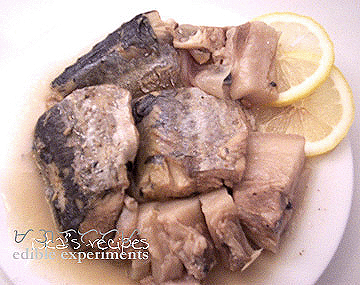
As always, whenever I have a missing ingredient, I try to come up w/ a substitute. In my case, kamias is unavailable here so I proceeded w/ my favorite souring agent – lemon. Also, it is cooked traditionally in palayoks over open fire which I didn’t do here. Anyways, there is really something remarkable about cooking w/ palayok. It’s a porous material that heats food evenly without burning. Its rounded shape is said to keep the heat distributed differently. In the case of sinaing, the pork fat & kamias in the bottom are cooked with direct heat, while heat on the sides and in the middle are diffused ensuring that the fish would not disintegrate. The rounded bottom ensures that everything will be cooked with its own juices, whereas the narrowing and rounding top maintains the moisture of food so that the broth will not evaporate and keeps it cooking in its own steam.
 Ingredients for Sinaing na Tulingan:
Ingredients for Sinaing na Tulingan:
1 large tulingan fish, cut into 3 or 4 parts
1 cup of lemon juice
1 cup of pork fat in chunks
1 onion, cut in halves (optional)
salt
Arrange the fish over the chunks of pork fat & onions. Pour enough water, about half an inch above the fish, and bring to a boil. Add salt and half of the lemon juice. Simmer until there’s about a cup of fish sauce left. The stew remained at a simmer for hours. Pour the remaining lemon juice & simmer for another minute. Don’t worry if the sauce is salty. It is supposed to be that way. We call it patis (natural fish sauce) and is great mixed with plain rice.
My 2nd treat is Italian inspired. I came upon an article from about a hotel restaurant in Batangas that served pasta with sinaing na tulingan. They call it Pontefino Pasta. Tuna spaghetti is actually Spaghetti all Acciughe e Tonno in Italian. Sa Batangas… ala eh tulingan spaghetti lang yaan. They have also referred to it as free style Batangas cuisine, which means standard Batangas fare freely interpreted, but with the utmost respect for the ingredients and the traditions of the province.
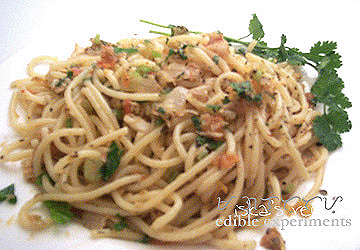
I’ve never been to this hotel though I wish I could somehow try it sometime in the future. But then, all I need to know is that the dish is pasta with shrimps and flakes of sinaing na tulingan tossed in olive oil, basil, garlic and parmesan cheese, and I already know what to do. Voila! Another edible experiment! It’s not always a sin to be unorthodox in cooking.
Ingredients for Tulingan Pasta:
1 pack of spaghetti (or penne)
olive oil
1 clove of garlic, crushed
about 4-6 pcs. of anchovy fillets (on the 2nd thought, i should have tried bagoong balayan instead), crushed
1 cup of my leftover sinaing na tulingan, shredded into large flakes
2 tomatoes, diced
2 tbsp chopped onions
Italian herbs (still this little bottle w/marjoram, basil, red bell pepper, rosemary, oregano, parsley & thyme)
parmesan cheese
1/2 cup of fresh parsley, minced
salt and freshly ground black pepper
1/2 cup coarse, lightly toasted bread crumbs
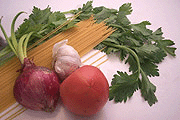 Cook the spaghetti in boiling salted water until al dente – tender but still firm to the bite. Drain and reserve about a cup of water.
Cook the spaghetti in boiling salted water until al dente – tender but still firm to the bite. Drain and reserve about a cup of water.
Meanwhile, heat about 2 tbsp of olive oil in a pan, add the garlic and fry over low heat until golden brown. Add the anchovy fillets and the tulingan. Toss for a few minutes then stir in the tomatoes & onions, add the pasta water, and simmer for about 2 minutes. Turn the heat low or totally turn it off. Toss the spaghetti with the sauce, mix in parsley and about 2 tbsp of olive oil and season to taste. Remember that the tulingan and anchovies are already salty. Add a little of the cooking water if the pasta seems too dry. Top w/ bread crumbs, parmesan cheese & more Italian herbs and serve hot.
 It’s definitely late to go trick o’ treating and I assume my regular readers are just like me who has no patience w/ gaming of any kind but then hey! Loosen up a bit especially those with weary souls. With the latest news in the blogosphere? Channel your anger (or whatever) and click on the zombie to start blasting their heads off!
It’s definitely late to go trick o’ treating and I assume my regular readers are just like me who has no patience w/ gaming of any kind but then hey! Loosen up a bit especially those with weary souls. With the latest news in the blogosphere? Channel your anger (or whatever) and click on the zombie to start blasting their heads off!
In Memoriam:
Monique Moll, a dear friend & a godparent to my son, who cooked her favorite halabos na alimasag (remisniscent of my mom’s recipe) countless times for us.
February 16, 1974 – November 1, 2004
He took you home and gave you rest.







I love sinaing na tulingan but haven’t yet tried cooking it. Hindi ako sanay mag-prepare ng tulingan dahil may lason daw iyon sa may buntot.
Hi, Iska, I think it should be a sin NOT TO BE UNORTHODOX in cooking.
I would like to try the tulingan pasta one of these days. Being a Pangasinense, I never knew tulingan until my husband spent two years in Lipa, when all I ate was tulingan and maliputo (well of course, along with lomi, pancit guisado, the palengke leche flan, bulalo.). I was warned that tulingan was poisonous, but now I just ask the fishmonger to pull out the tail. I love it cooked in gata.
Ang sarap naman nyang Sinaing na Tulingan! Penge!!
ei! parang gusto ko try yan pasta na yan..ma-recognize ko kya ang tulingan dito? tilapia lang alam ko bilhin dito e..other than salmon..hmmm hahahah
hi lani & kai! i really don’t know where the lason is. we just treat tulingan like any kind of fish. like Kai, just ask the fishmonger to pull out the tail. para sigurado.
hi celiaK! yang tulingan na yan ang request ko parate sa mom ko pag nasa pinas ako.
hello ces! u can use canned tuna chunks for the spaghetti. if it’s sinaing u wanna try, tilapia is fine. check this page…
naku, iska, this is my lolo’s specialty. the pork fat is indeed a must! haay, inggit! i haven’t had tulingan in years, rarely see it here.
Hi Iska! I have never heard of sinaing na tulingan before but it sounds wonderful! See, that’s why I love these LP events! Ok, I see you have already told Ces that tilapia is fine as a substitution (one of my questions). Also, tried malitputo for the first time this year and LOVED it! Can that be used for the sunaing as well? Another question: Sorry, if this sounds dumb but I have never cooked with a palayok so I have to ask… can I cook with a palayok on my stove top? It’s gas so there is a flame, does that count? Sorry so ignorant but I am dying to cook with palayok and have no idea how to go about it! How do you wash it also?
Another question: Can I used fresh kamias instead of dried?
Sorry so kulit! Love this entry!
Well written post, Iska! I love both tulingan recipes. Tulingan is same as tuna, right? I’m wondering if I can substitute tuna?
hello joey, my mom used different types of fish for sinaing. i remember tilapia & sapsap (though not simmered for more than an hour) so i think maliputo is just fine. if i were u, i will try it hehehehe. mom even used dilis. just remember to cook over low fire para d magkagulagulanit ang isda. u may also wrap them in banana or mustasa leaves. fresh kamias is also fine. ako nga i used lemon here in beijing. back in brunei, i used sinigang mix tee hee. about the palayok, we also used it over flames of a gas stove top. on cleaning it, here’s an article for u
hi JMOM! yes, tulingan is tuna. if im not mistaken, its the frigate variety. the one i used above is also another type, it’s bigger. pareho din ang lasa… so JMOM and stef and ces, try it w/ whatever type of tuna available to u.
Thanks a lot Iska! That really helped! Now all I have to do is buy one… I’m so excited!
ito ang bagay sa sinaing na yan….
and that tells me to look for mackarel today.. just too busy am your lurker with a .gr isp lol
will be back…
hi kali! i haven’t tried that dish before but i would give it a try someday when I know where to find the main ingredient. also, u do have a very interesting site i can recommend to my male friends…
hello sha! you are welcome here anytime
Tulingan…sis ung first time kong magluto ng isdang yan.i forgot to cut or full ung tail nya….ang ginawa ko ung half ng fish nlng tinanggal ko…para safe…after that nun ko plang siya niluto….wow..sarap talaga
sarap! Thanks for the recipe. Everyweek i bought sinaing na tulingan from a Batanguena with a very large clay pot. Now i know how to do it. mabuhay ka!
hayyy mersmerising sarap talaga ng sinaing na tulingan nakamiss tuloy lalo na dito sa kuwait wala nyan kaya pag akoy nauwi ng batangas kada bakasyon ay iyan agad ang aking gustong ulam…kasi tubong batangas din ako sa sto tomas kaya pag kayo ay nadadaan sa sto tomas ay specialty din iyan ng aking tita sa kanyang restoran sa sto tomas ang nene and trining (formerly sinoy and trining) at ang pinapgpipitaganan naming famous rose and grace restaurant ng aking butihing tita (nana cita) musta na kayo dyan… me pabati pa yan ha at promo…(sister po sila ng aking butihing ama)…syempre po ipinagmamalaki ko po iyan dahil iyan na po ang isa sa symbolo ng bayan ng sto tomas ang famous bulalo ng batangas….salamat po sa colum at sa recipe ng aunthenthic batangas sinaing na tulingan na ipinapamahagi po sa lahat na sanay subukan at matikman ang lasa ng batangas….samahan nyo na ho ng kapeng barako….more power….
I was searching the web for a tulingan recipe and i came across this site. I grew in Batangas and still live here but i have never tried to cook the sinaing na tulingan before (I usually order it from someone or buy from a lady selling it in the late afternoon). Well I plan to try your recipe out tomorrow, I have the palayok waiting. The nice thing about tulingan is you can make a lot and it doesn’t really spoil fast (you can refrigerate it too). If you are tired of the sinaing try frying the left over sinaing, it’s yummy!
I’ve tried the pasta Pontefino and it does taste good, it is a must try!
hi mario! how’s your tulingan? hope everything went well…
jattremura, mukhang talagang tamang senti ka tulad ko na nami miss ang luto ng nanay ko kaya heto talagang paminsan minsan hinahanap hanap ko na sya mabuhay ang lutong batangas!
mabuhay ang lutong batangas!
try it abby! don’t know if my recipe will be good enough hehehe but just try it, it’s quite easy to prepare
I’d like to subscribe for the recipes of lasang pinoy. thanks
Lasang Pinoy has been on hiatus for a long while now as the bloggers/writers became busy. But you can still read all the posts through the links here:
http://karen.mychronicles.net/lasang-pinoy/
Happy reading
you forgot the “adobong dilaw” in your list of batangueno food. adobo cook with aswete.
Thanks for reminding, Mon.